The Togean Islands
The Togean Islands are situated in Indonesia in the Gulf of Tomini, which separates Central-Sulawesi from North-Sulawesi. The archipelago consists of many small islands, most of them covered with dense jungle. An active volcano, Una Una, also belongs to this stretch of islands. The dark green of the islands and the crystal clear water is a perfect setting and has attracted many travelers during the past years. Quite a number of homestays and bungalows on the islands offer basic facilities for the foreigners.
During the rainy season there is a high risk of malaria tropica on these islands
During the rainy season there is a high risk of malaria tropica on these islands
Getting there
By bus
Travelers coming from the South follow the Trans Sulawesi Highway to Poso and from there to Ampana. In May 2000 serious unrest broke out in the Poso region. In 2002, Muslim terrorists attacked a bus near Poso. An Italian tourist was killed. Of the devastation of Muslim and Christian towns that took place back then, however, little can be seen today. In late 2019, four members of a Christian sect were massacred by Islamic terrorists near Palu.
The situation in the region is obviously still unstable today, despite the fact that the police are intensively searching for the remainder of this group of Muslim terrorists. It is believed that they retreated to the inaccessible mountains in the south.
I therefore recommend that you get detailed information about the current situation in this region before leaving Makassar. Your Foreign Office offers current information and travel warnings.
The crossing from Ampana to the Togian Islands takes between 2 and 4 hours, depending on the destination and the ferry selected.
The journey from the north leads via Gorontalo, which can be easily reached by bus from Manado. There you can take the ferry that runs twice a week in 12 hours overnight from Gorontalo to Wakai (Togian Islands).
By plane
There are flight connections to Gorontalo as well as to Ampana. Gorontalo is better connected to the Indonesian flight network than Ampana.
By ship
All visitors to the Togean Islands arrive by ship. From the north in Gorontalo, the KM Tuna Tomini leaves twice a week on Tuesday and Friday around 6 p.m. and arrives in Wakai on the Togean Islands in the early morning. From Marissa there is also the possibility to take a chartered boat to the Togean Islands (approx. 5 hours crossing).
From the south, in addition to the Tuna Tomini (Mondays and Thursdays), several smaller ferries alternate from Ampana to Wakai, some with a stopover in Bomba. There are also high-speed ferries that cover the route from Ampana to Wakai in around 2 hours.
You can also find current information about how to get to the Togian Islands on the Bodeblog.
Travelers coming from the South follow the Trans Sulawesi Highway to Poso and from there to Ampana. In May 2000 serious unrest broke out in the Poso region. In 2002, Muslim terrorists attacked a bus near Poso. An Italian tourist was killed. Of the devastation of Muslim and Christian towns that took place back then, however, little can be seen today. In late 2019, four members of a Christian sect were massacred by Islamic terrorists near Palu.
The situation in the region is obviously still unstable today, despite the fact that the police are intensively searching for the remainder of this group of Muslim terrorists. It is believed that they retreated to the inaccessible mountains in the south.
I therefore recommend that you get detailed information about the current situation in this region before leaving Makassar. Your Foreign Office offers current information and travel warnings.
The crossing from Ampana to the Togian Islands takes between 2 and 4 hours, depending on the destination and the ferry selected.
The journey from the north leads via Gorontalo, which can be easily reached by bus from Manado. There you can take the ferry that runs twice a week in 12 hours overnight from Gorontalo to Wakai (Togian Islands).
By plane
There are flight connections to Gorontalo as well as to Ampana. Gorontalo is better connected to the Indonesian flight network than Ampana.
By ship
All visitors to the Togean Islands arrive by ship. From the north in Gorontalo, the KM Tuna Tomini leaves twice a week on Tuesday and Friday around 6 p.m. and arrives in Wakai on the Togean Islands in the early morning. From Marissa there is also the possibility to take a chartered boat to the Togean Islands (approx. 5 hours crossing).
From the south, in addition to the Tuna Tomini (Mondays and Thursdays), several smaller ferries alternate from Ampana to Wakai, some with a stopover in Bomba. There are also high-speed ferries that cover the route from Ampana to Wakai in around 2 hours.
You can also find current information about how to get to the Togian Islands on the Bodeblog.
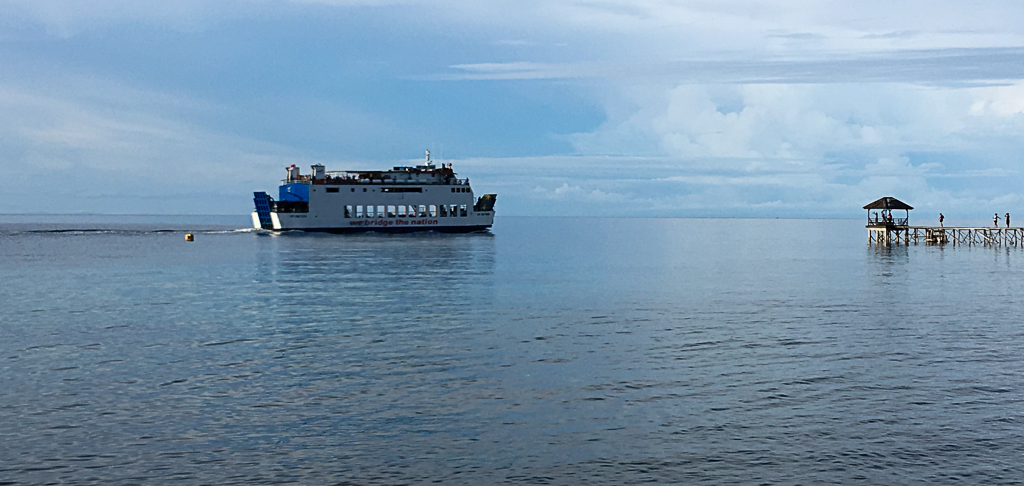
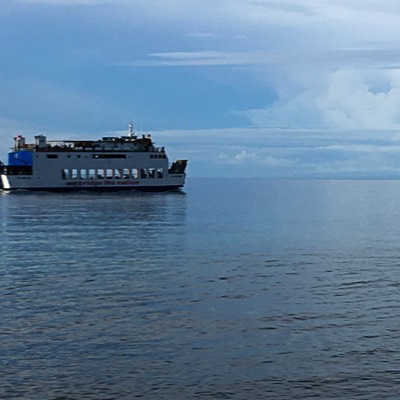
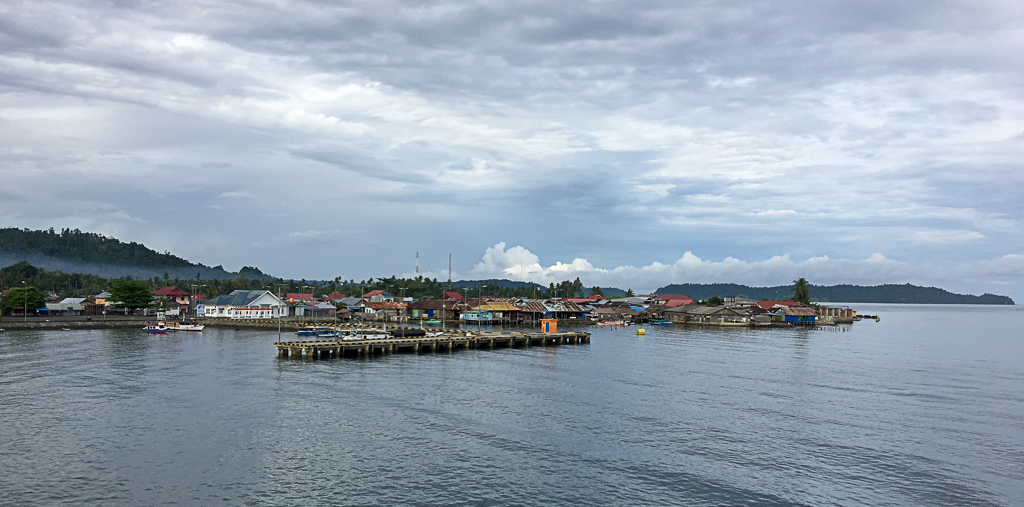
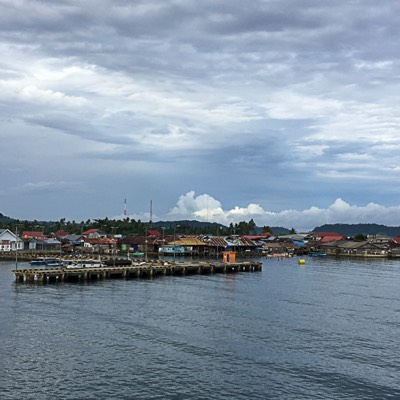
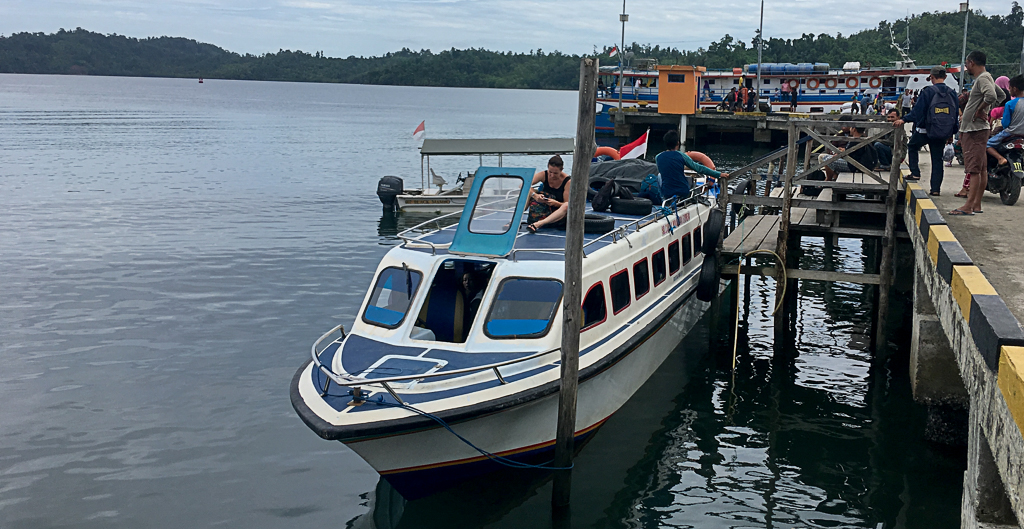
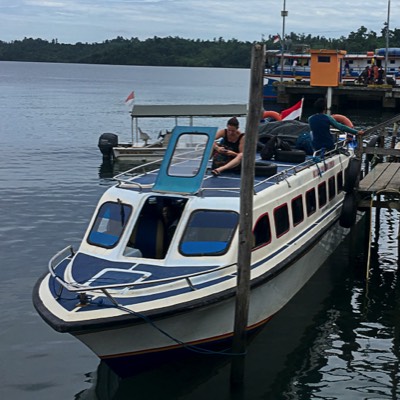
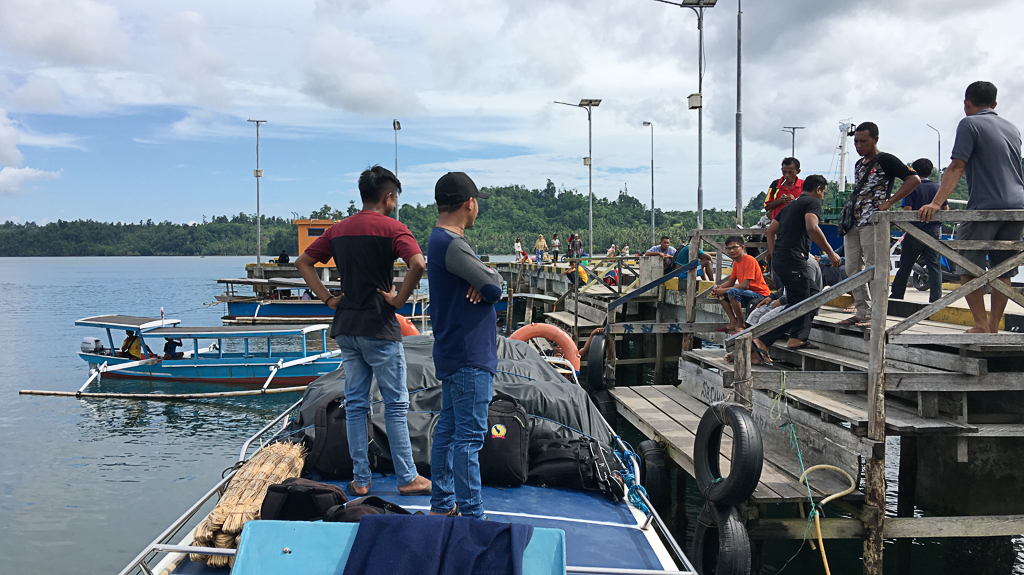
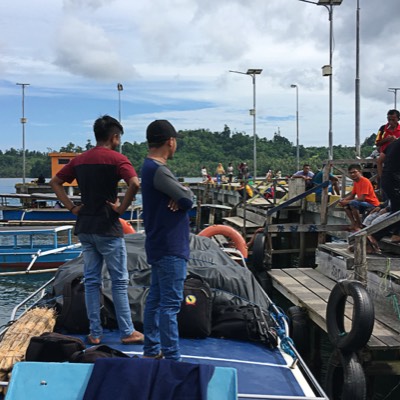
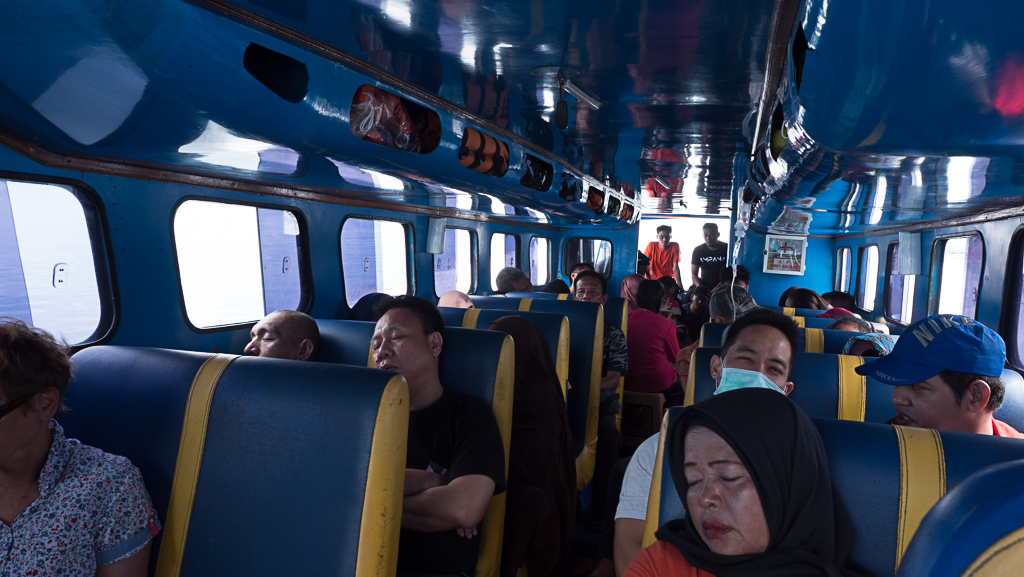
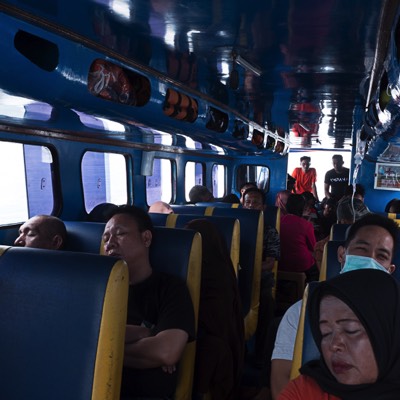
Where to stay on the Togian Islands
The Togian Islands are mainly visited by backpackers. Especially people with a lot of time but a low travel budget come to the islands and then stay there for quite a long time. The range of accommodation is therefore primarily aimed at this group of travelers . As there are no restaurants on the islands, all resorts offer full board. You will look in vain for luxury resorts such as Bali. Nevertheless, it can get quite crowded in the main travel season during the European summer months. As a rule, however, something suitable can always be found.
All Togean visitors arrive first in Wakai on the island of Batudaka with the ferries from Ampana in the south or Gorontalo in the north. All guests who has already contacted the resort of their choice will be picked up from here and taken directly to their accommodation by boat. Wakai also has simple accommodations where you can spend a night or two if necessary. However, the place is not recommended. The water is dirty and estuarine crocodiles roam near the muddy shore at night.
There are two resorts on Kadidiri's north side. We were very satisfied with our accommodation at Kadidiri Paradise. The better bungalows stand on stilts directly in the water and are very spacious. The food was excellent and varied. Only the Kadidiri Paradise has its own sandy beach and a long jetty from which you can enjoy the spectacular sunsets on the Togean Islands.
Right next door is the Black Marlin Dive Resort. The last remaining sandy beach has been washed away long ago, so that you can only relax on an artificial sandy area behind a protecting wall. Unfortunately, a large rock in front of the resort hides the setting sun every day. Many bungalows are situated in the blazing sun during the day and then heat up extremely.
The place makes a neglected and unkempt impression. The owner lives in Bali and is rarely seen on Kadidiri. Our bungalow was never cleaned in the nearly two weeks we stayed at the Black Marlin Resort. The Indonesian resort manager seems to do her own business with Indonesian guests who could spend the weekend at the resort for little money and who were incredibly loud and intrusive. I therefore strongly advise against staying at the Black Marlin Dive Resort.
The Harmony Bay Resort is located in a bay on the east side of Kadidiri. From the other two resorts in the north, this bay can only be reached after a strenuous walk. Guests will therefore be picked up in Wakai and brought to the resort. Similar to the Kadidiri Paradise, Harmony offers several wooden bungalows on the narrow sandy beach. The deluxe bungalows with a large veranda directly on the water made a very good impression.
All Togean visitors arrive first in Wakai on the island of Batudaka with the ferries from Ampana in the south or Gorontalo in the north. All guests who has already contacted the resort of their choice will be picked up from here and taken directly to their accommodation by boat. Wakai also has simple accommodations where you can spend a night or two if necessary. However, the place is not recommended. The water is dirty and estuarine crocodiles roam near the muddy shore at night.
Kadidiri
Most visitors to the Togean Islands spend the first days on the small island of Kadidiri, about 30 minutes by boat from Wakai. The accommodations presented below also have their own diving centers.There are two resorts on Kadidiri's north side. We were very satisfied with our accommodation at Kadidiri Paradise. The better bungalows stand on stilts directly in the water and are very spacious. The food was excellent and varied. Only the Kadidiri Paradise has its own sandy beach and a long jetty from which you can enjoy the spectacular sunsets on the Togean Islands.
Right next door is the Black Marlin Dive Resort. The last remaining sandy beach has been washed away long ago, so that you can only relax on an artificial sandy area behind a protecting wall. Unfortunately, a large rock in front of the resort hides the setting sun every day. Many bungalows are situated in the blazing sun during the day and then heat up extremely.
The place makes a neglected and unkempt impression. The owner lives in Bali and is rarely seen on Kadidiri. Our bungalow was never cleaned in the nearly two weeks we stayed at the Black Marlin Resort. The Indonesian resort manager seems to do her own business with Indonesian guests who could spend the weekend at the resort for little money and who were incredibly loud and intrusive. I therefore strongly advise against staying at the Black Marlin Dive Resort.
The Harmony Bay Resort is located in a bay on the east side of Kadidiri. From the other two resorts in the north, this bay can only be reached after a strenuous walk. Guests will therefore be picked up in Wakai and brought to the resort. Similar to the Kadidiri Paradise, Harmony offers several wooden bungalows on the narrow sandy beach. The deluxe bungalows with a large veranda directly on the water made a very good impression.

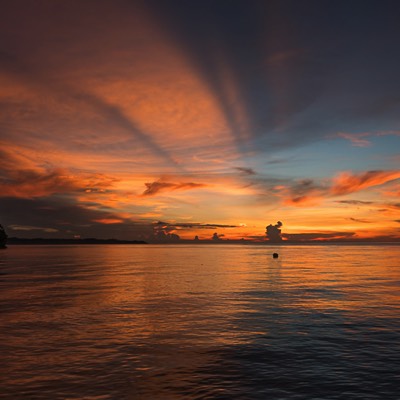
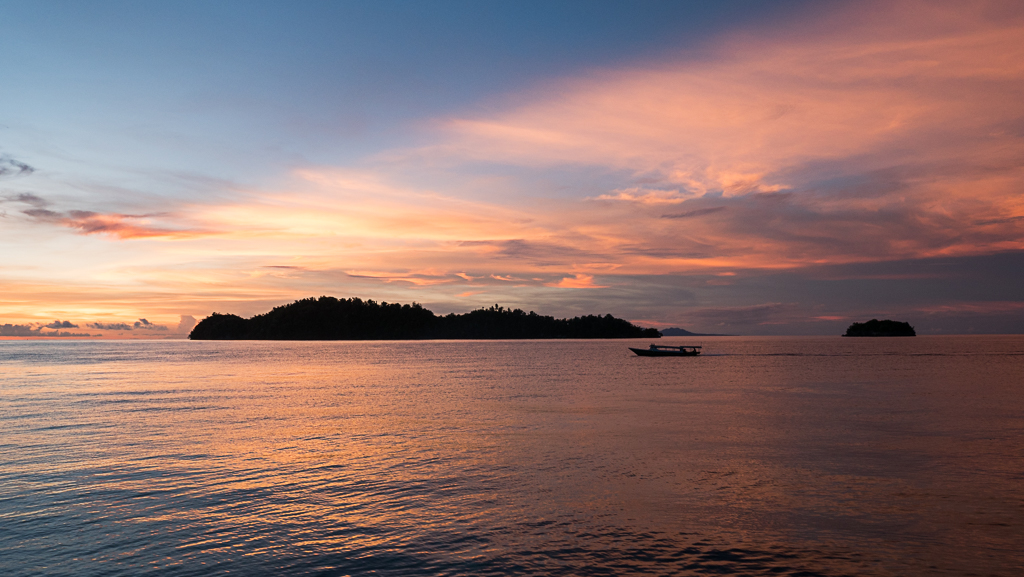
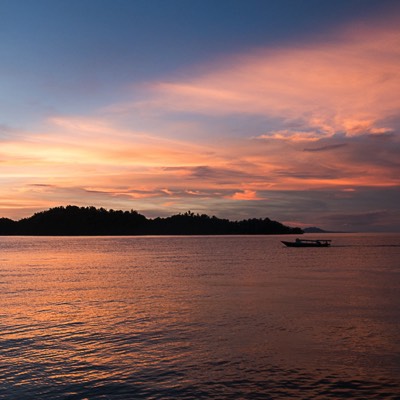
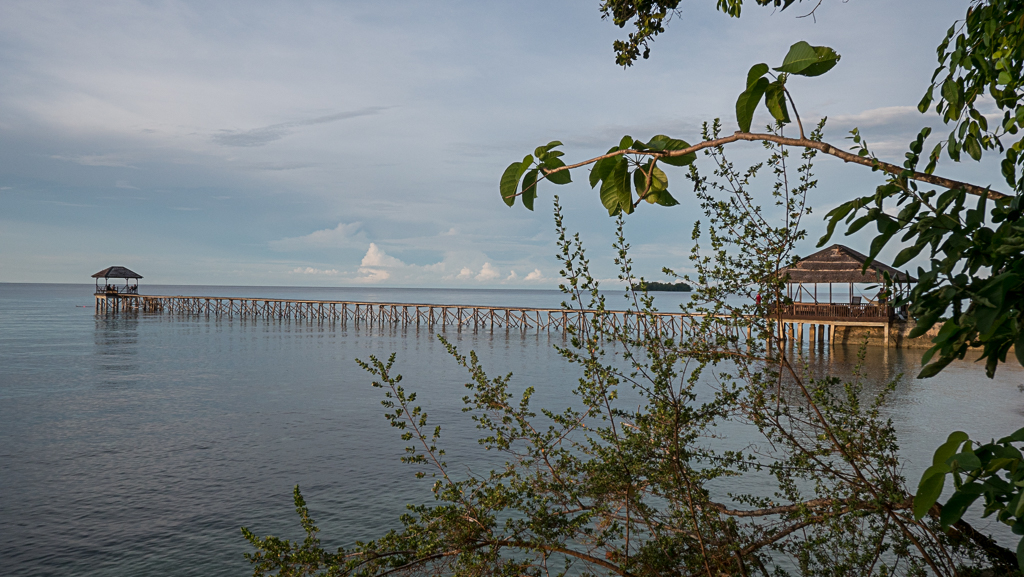
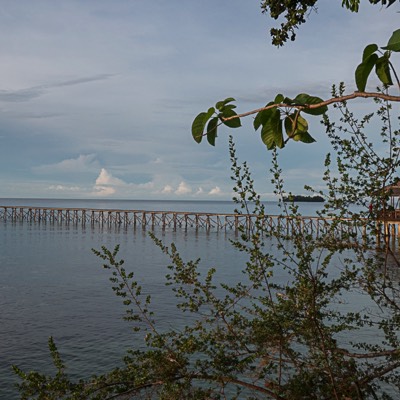
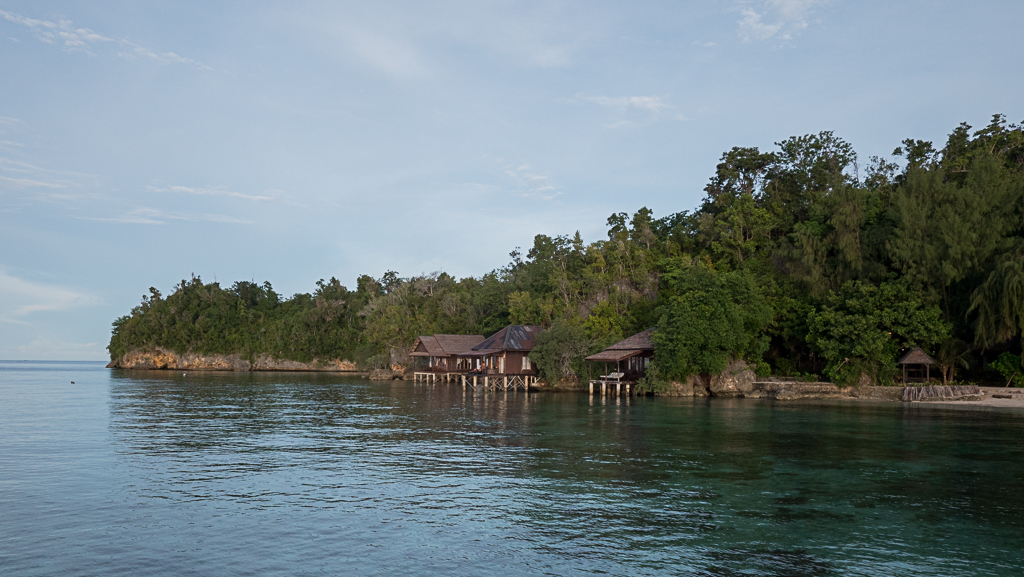
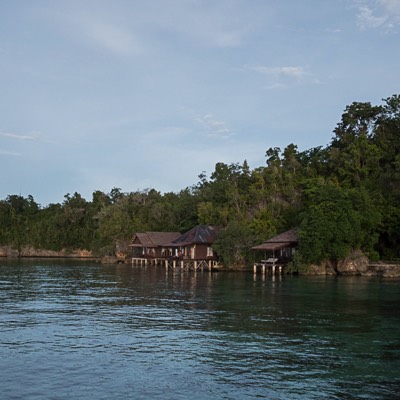
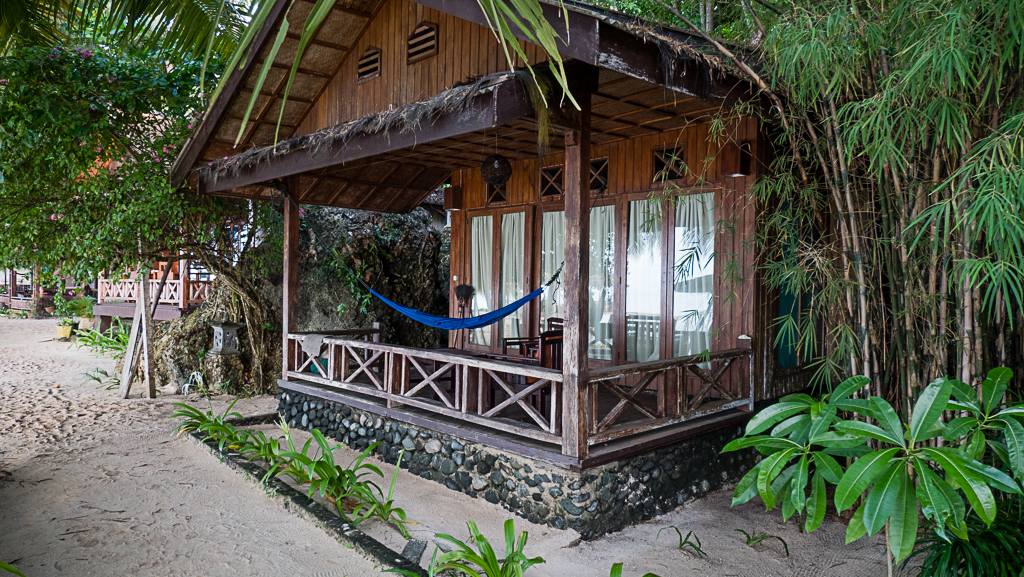
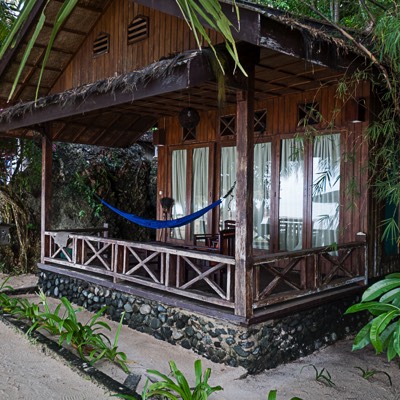
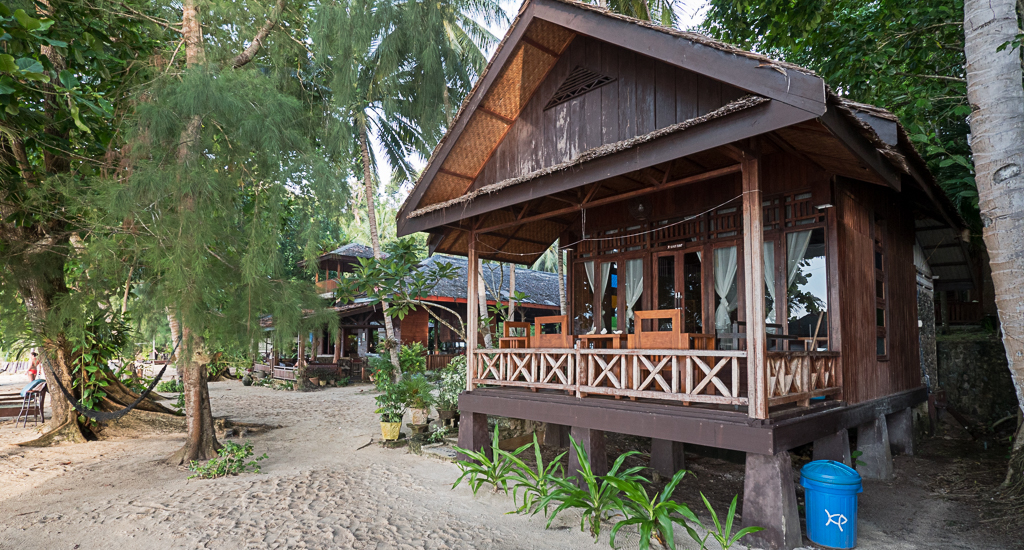
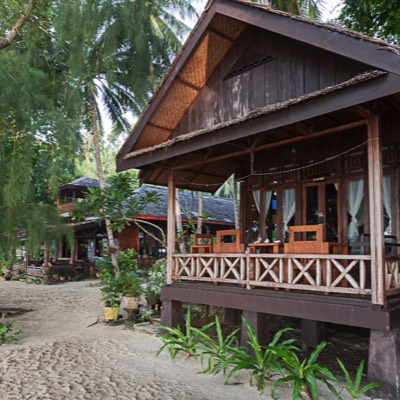
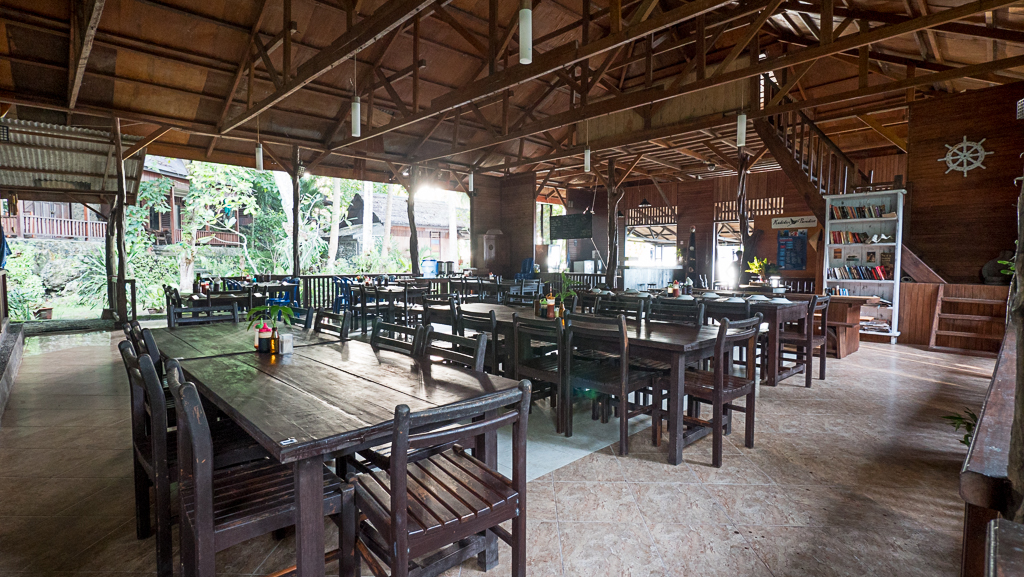
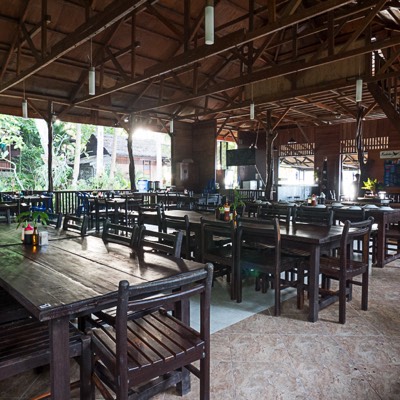
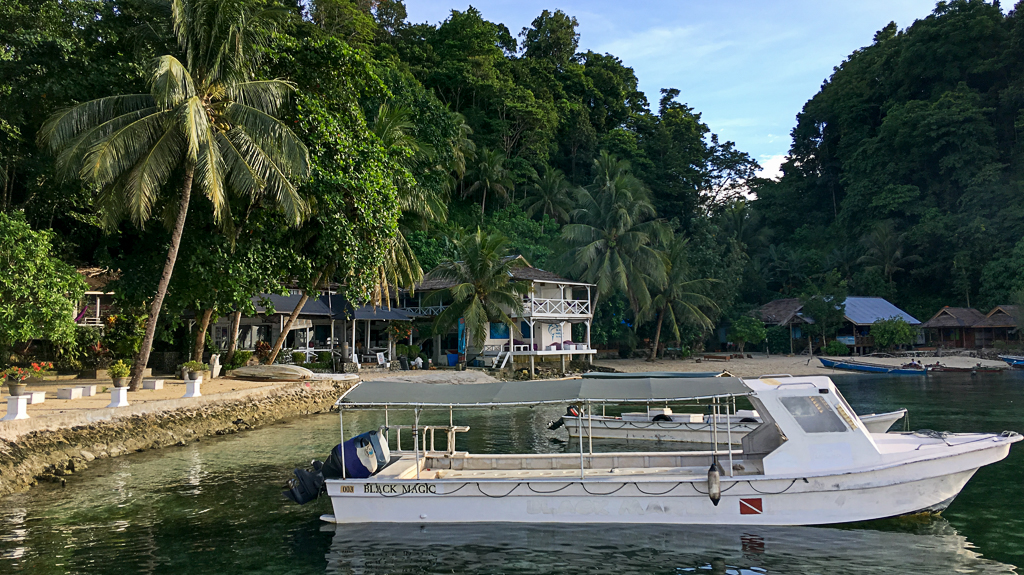
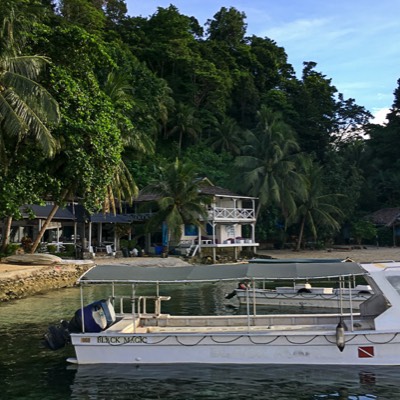
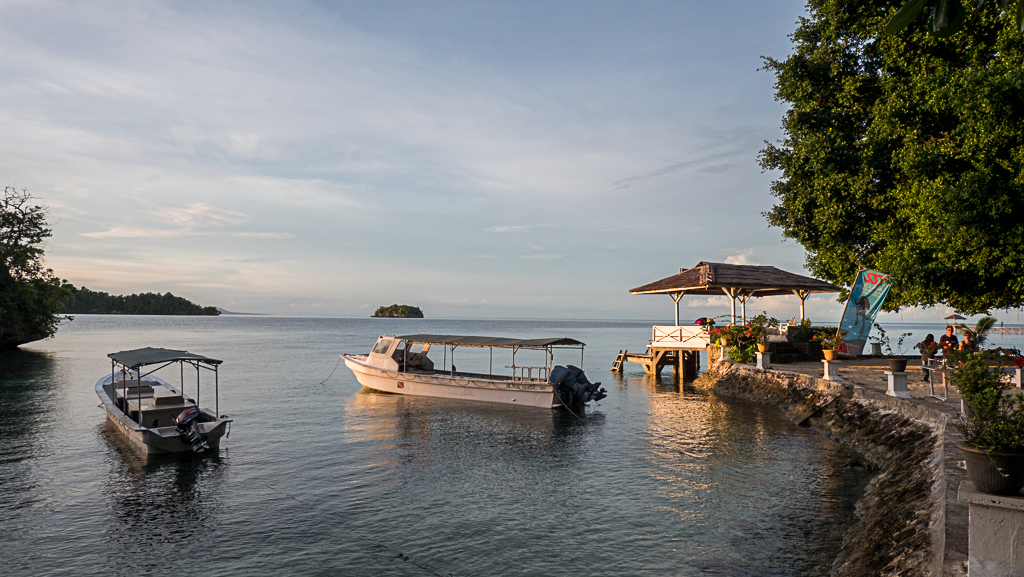
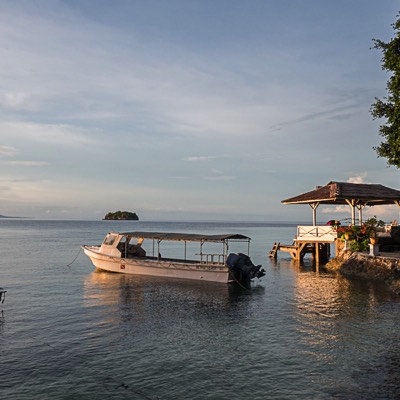
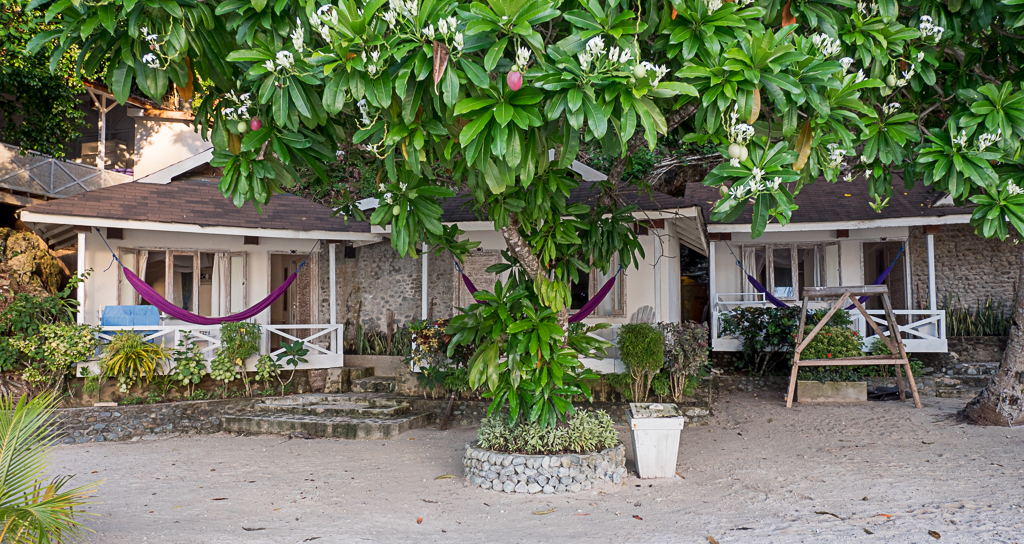
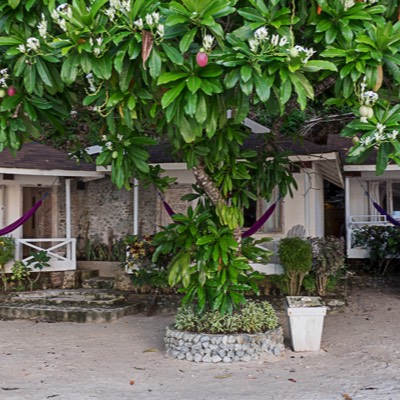
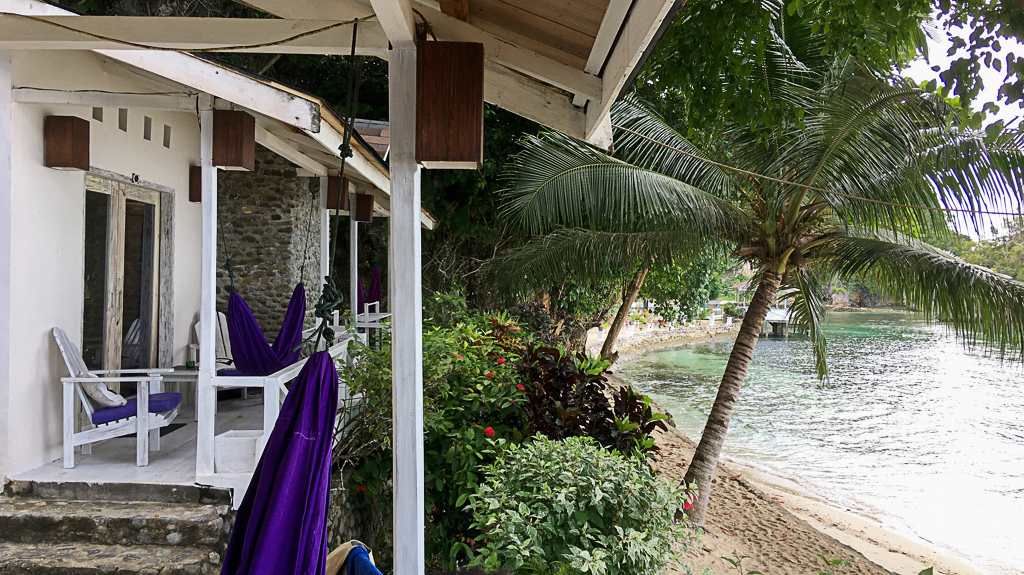
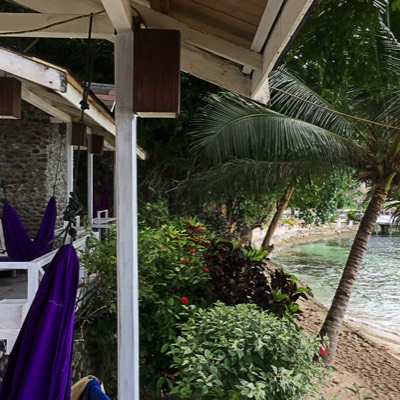
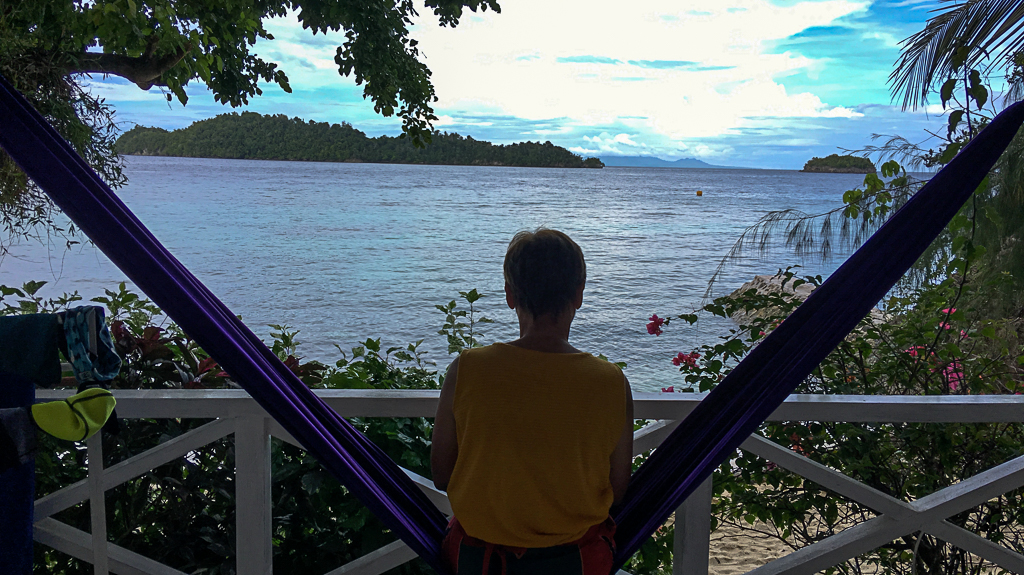
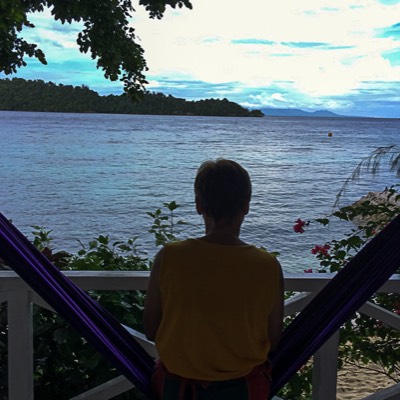
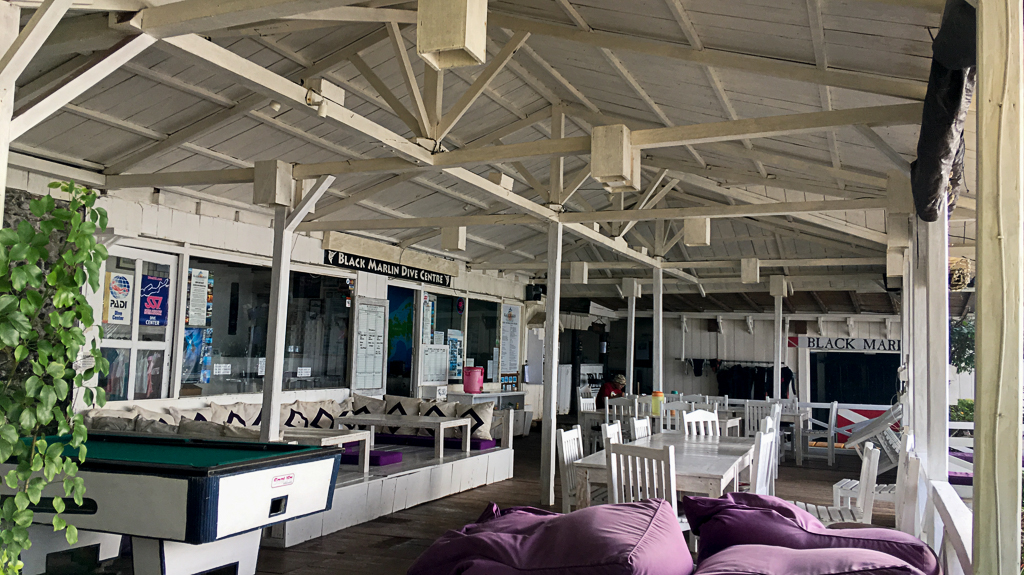
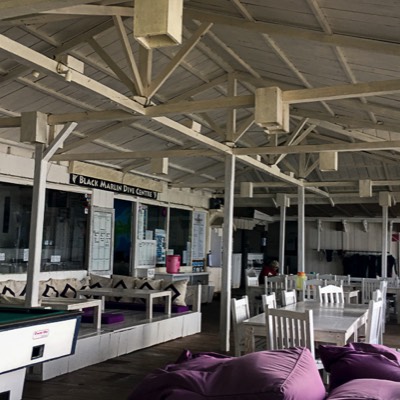
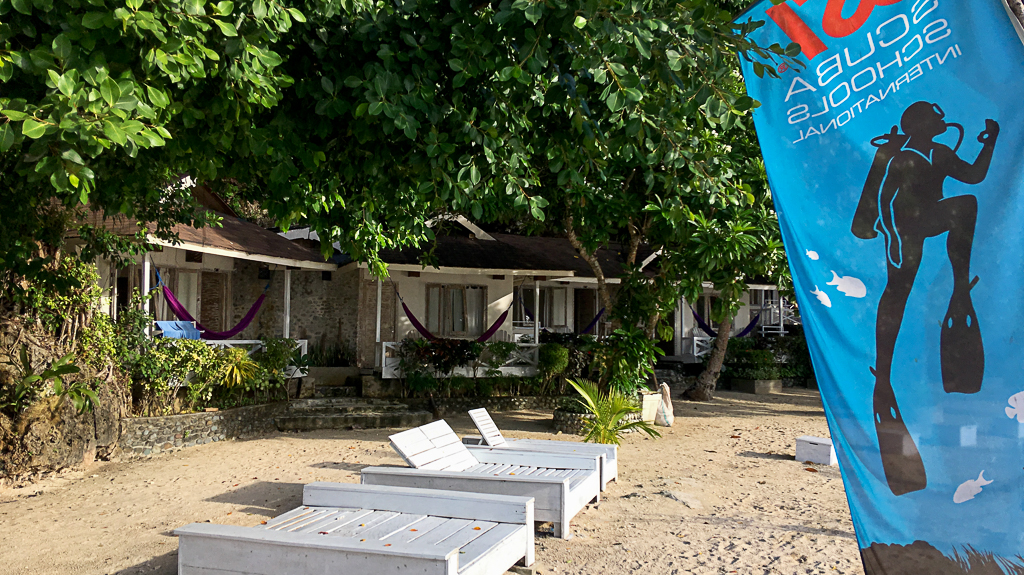
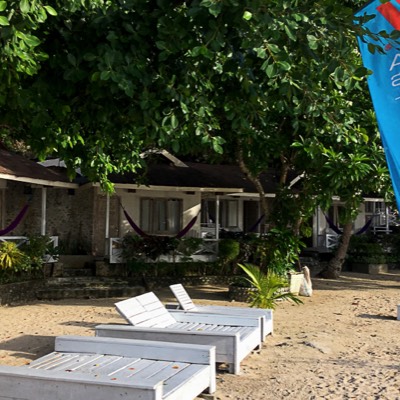
Bomba
In the vicinity of the village of Bomba on the island of Batudaka there are two other resorts with attached diving centers. Bomba is often approached by the ferries going to or from Ampana as a stopover, so that visitors can also get on or off here. However, it can happen that ferries that are already too full in Wakai do not accept any more guests in Bomba. Then you may have to wait a day for the next ferry.The Araya Dive Resort is beautifully situated on a slope directly above a sheltered bay. The new deluxe bungalows are located on a hill in the jungle and offer beautiful views of Tomini Bay. The rooms in the Dive Lodge are cheaper. Some guests also stay at the nearby Poki Poki and dive with the Bomba Divers of the Araya Dive Resort.
The Togian Island Retreat also offers diving opportunities. A total of 20 wooden bungalows are available to guests here. The oceanfront cottages with large double beds and their own bathroom / toilet are recommended here. In the second row are the Garden Cottages with shared bathroom / toilet.
Una Una
The best diving spots on the Togean Islands are undoubtedly off the volcanic island of Una Una. After the last devastating eruption of the Colo volcano in 1983, all 7000 residents had to leave the island and could not return for years. That has changed in the last few years. More and more people are returning and the first small settlements have emerged. Even two simple diving resorts have now opened their doors on Una Una.The Sanctum Una Una has 18 simple accommodations arranged in a semicircle. Some (deluxe) of them have a private bathroom / toilet. The guests in the standard rooms have to share the sanitary facilities. There is even a - albeit dirty - pool. You don't want to jump in there, however. Thanks to the active volcano on the island, warm water is also available, which comes from underground springs.
The Pristine Paradise Dive Resort is right next to the Sanctum. It was only created in 2017 and in its current stage of development offers accommodation in 6 wooden bungalows with bath / toilet. As in the Sanctum next door, the small dive center is housed in a simple hut on the black beach.
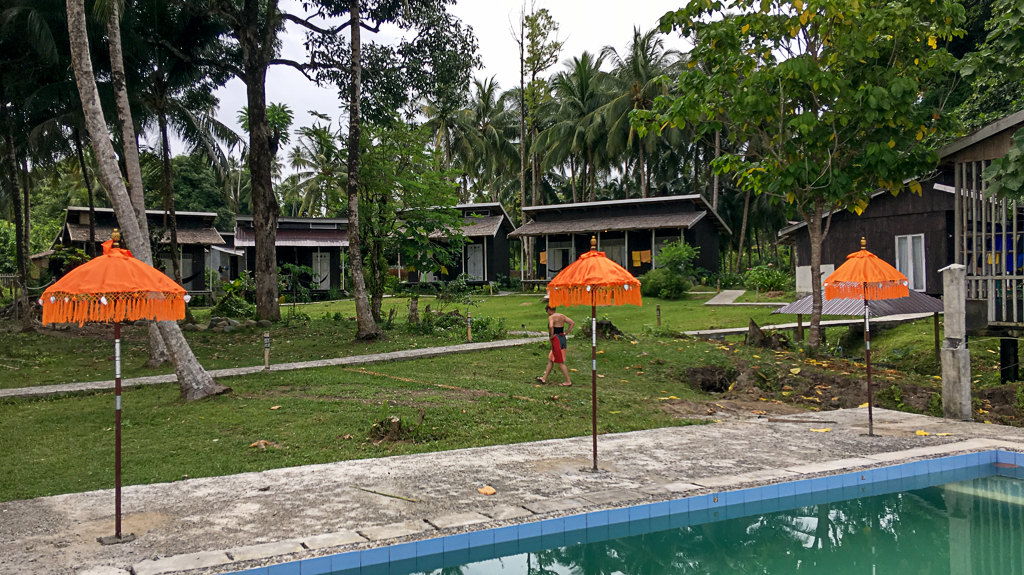
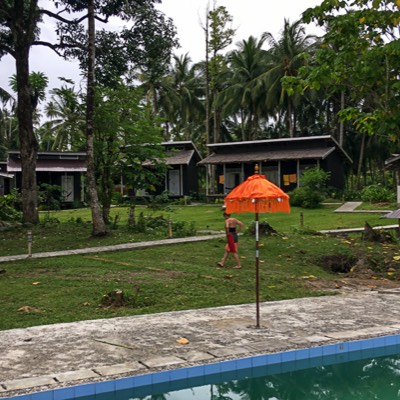
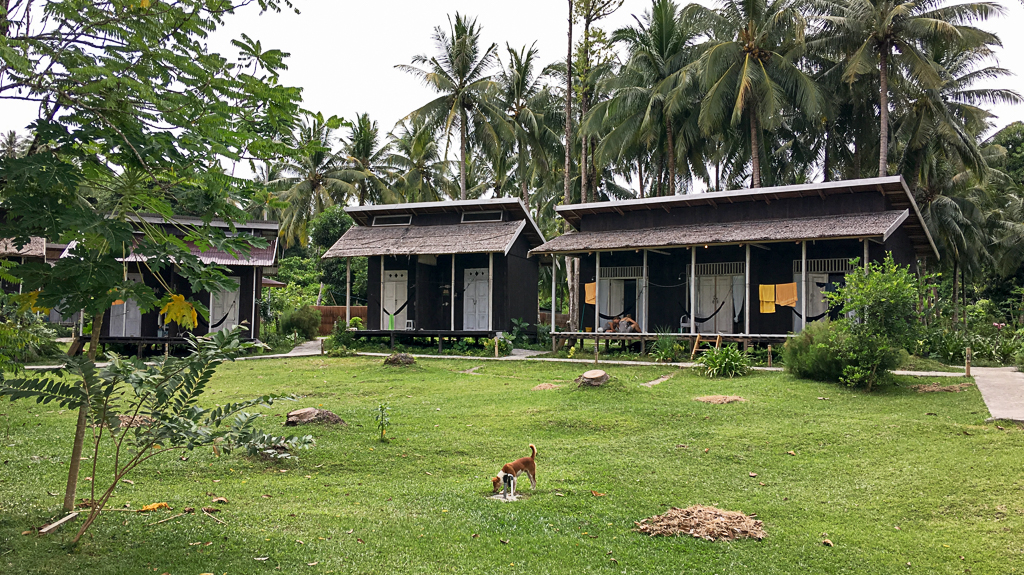
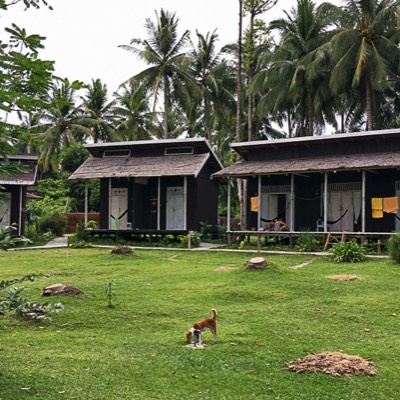
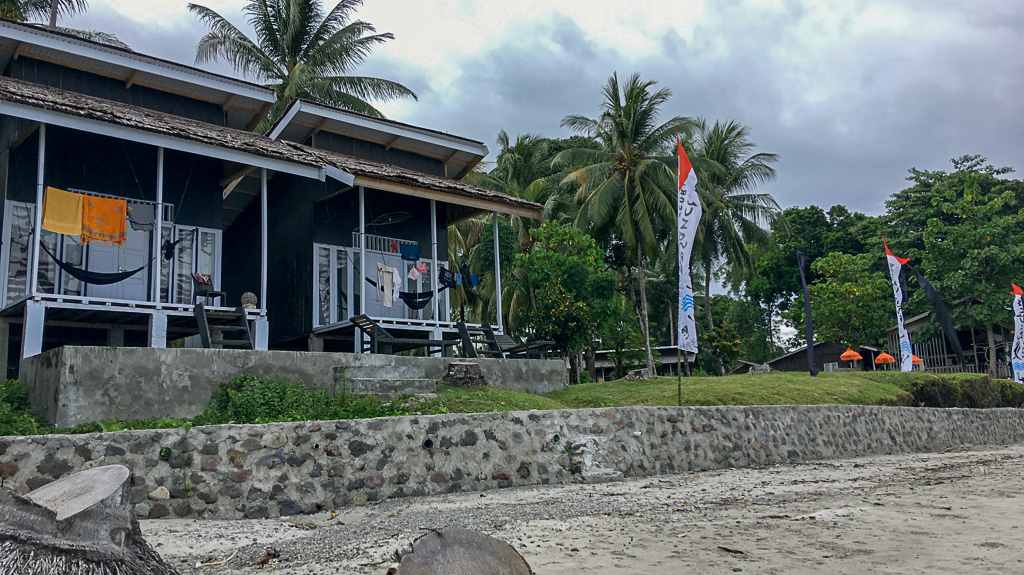
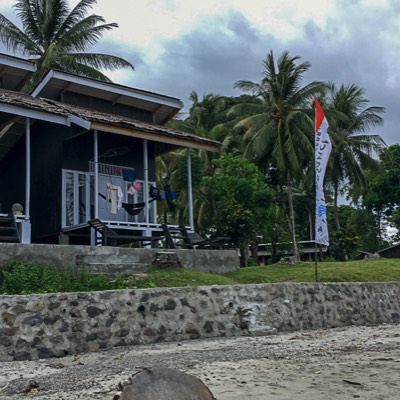
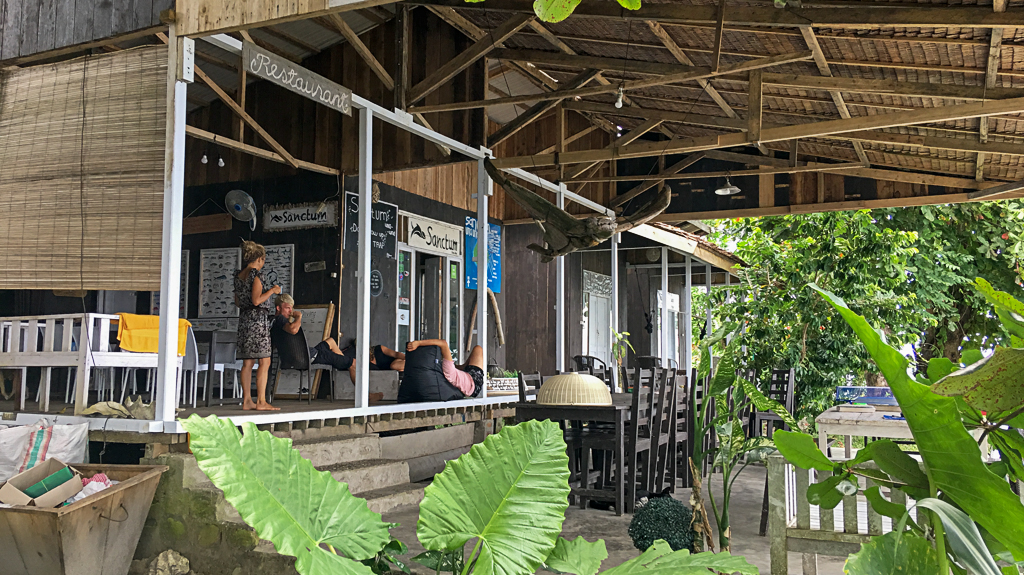
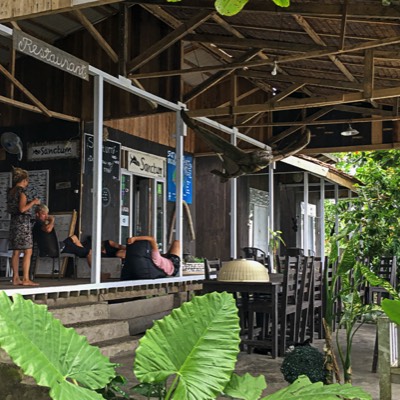
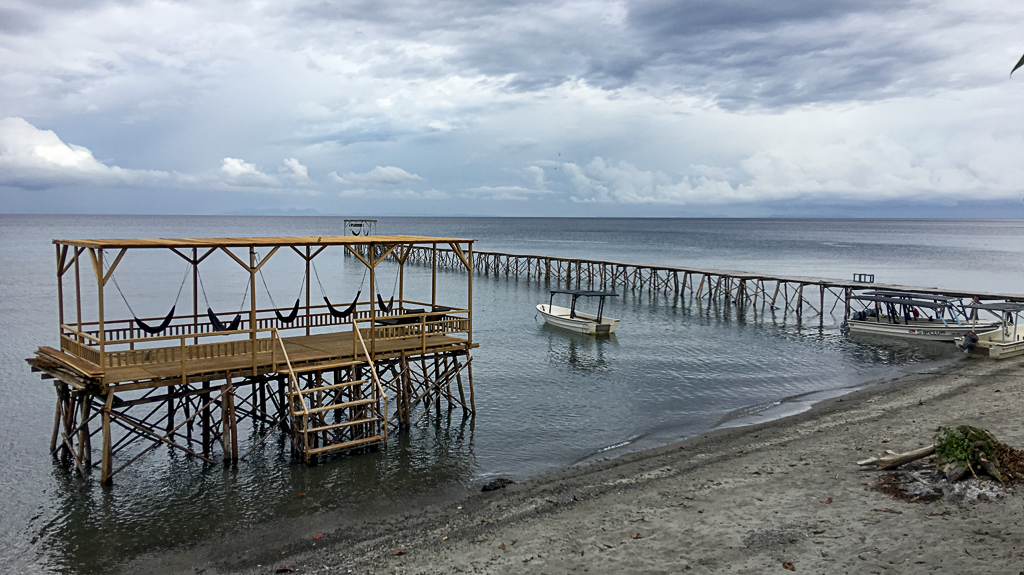
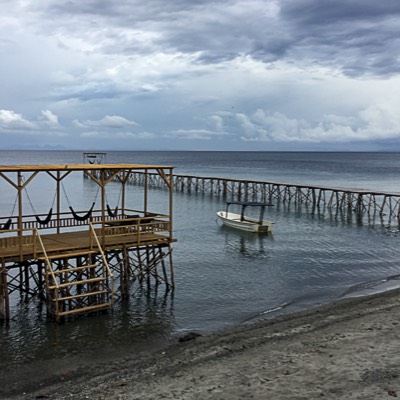
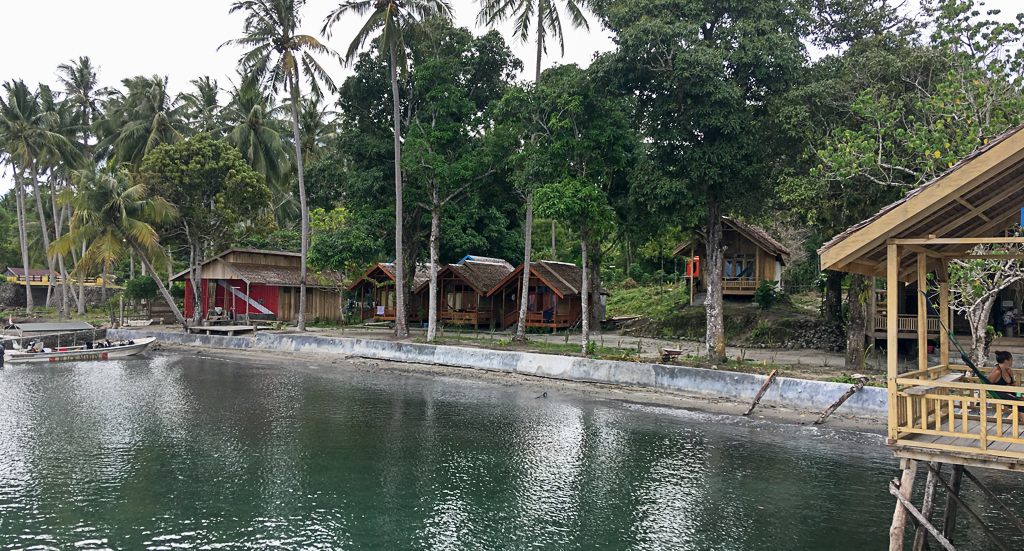
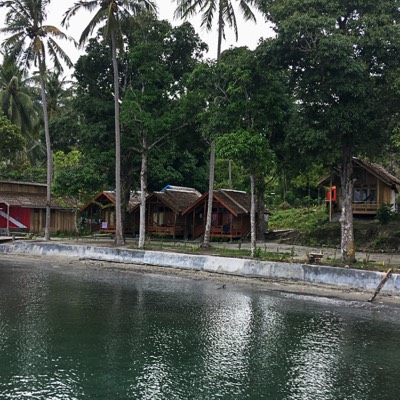
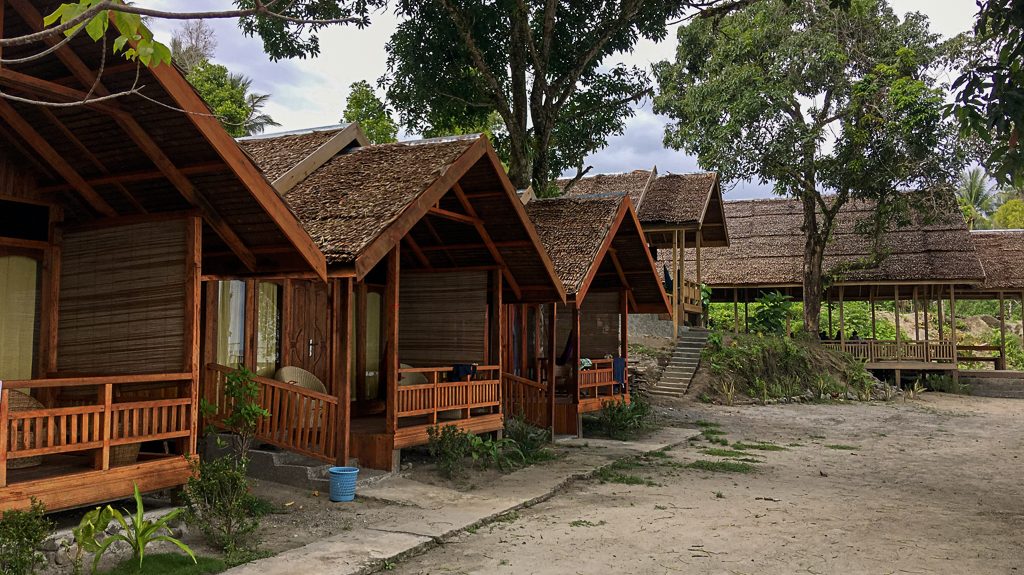
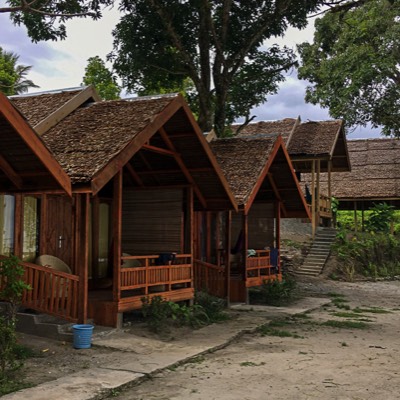
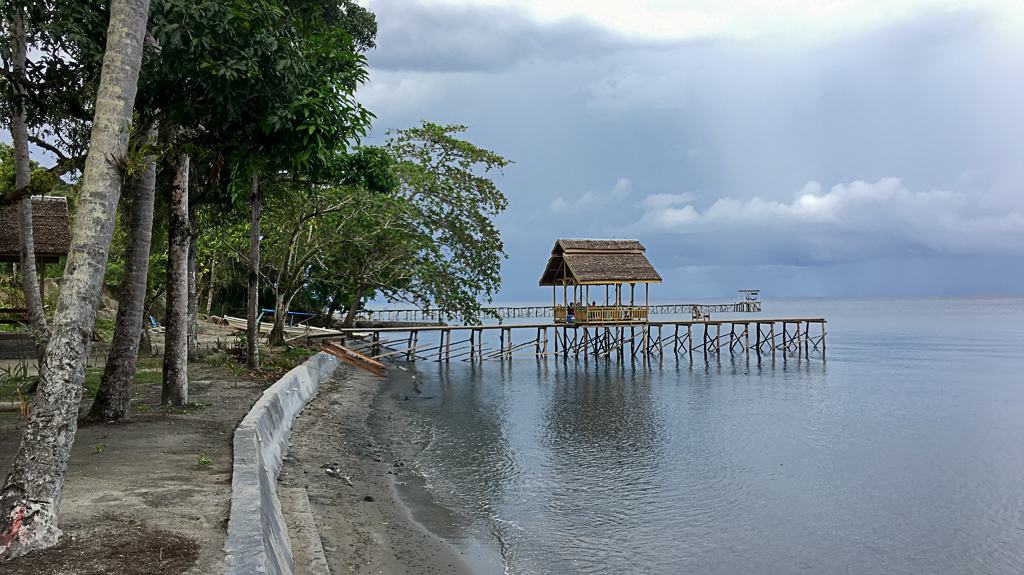
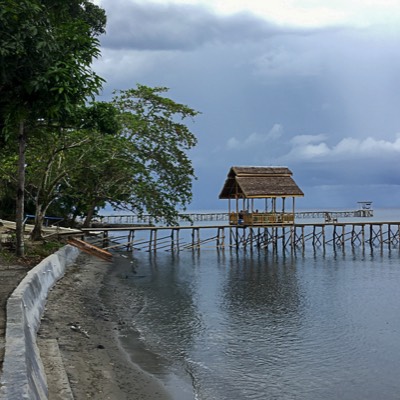
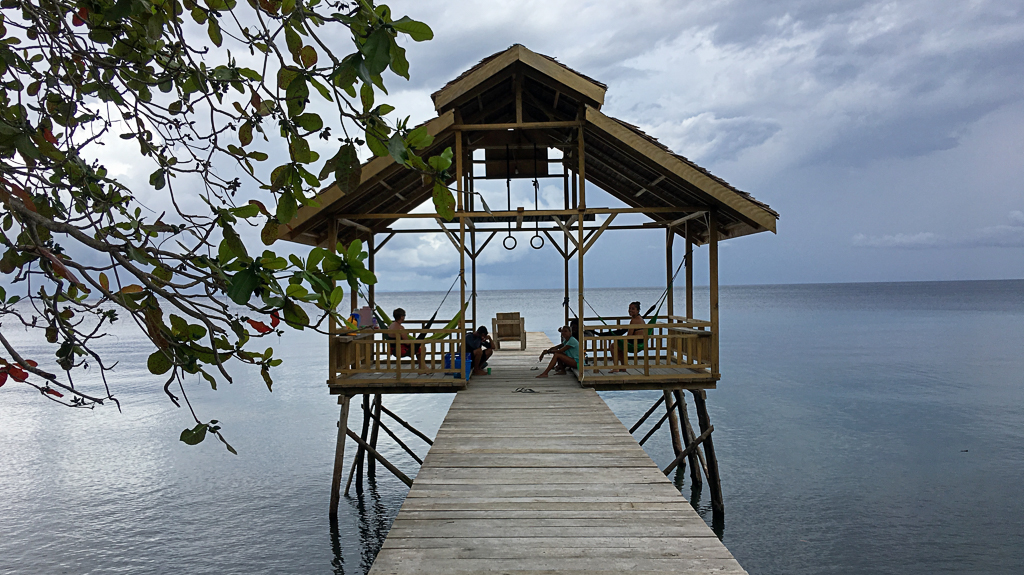
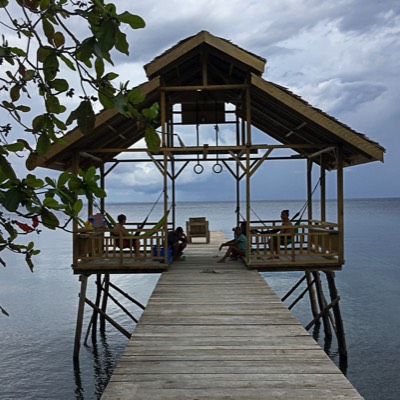
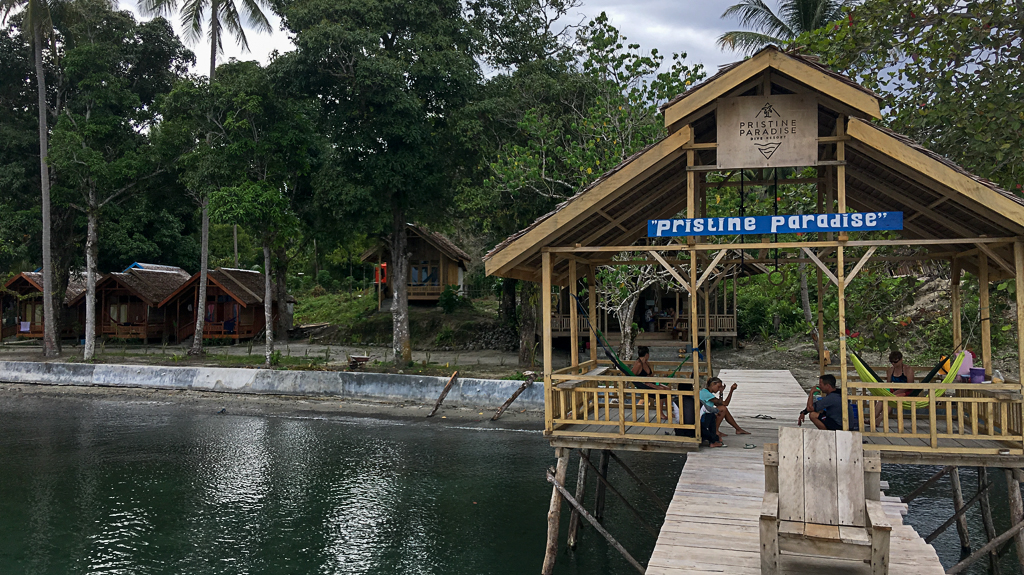
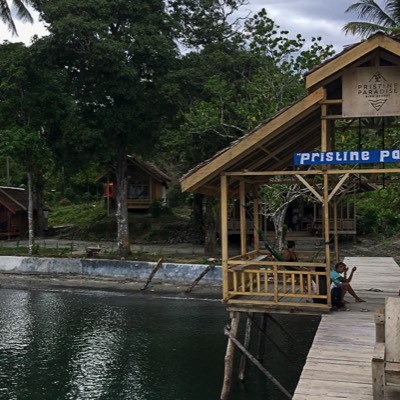
Diving the Togean Islands
The Geography of the Togean Islands
The location of the Togean Islands in the huge Tomini Bay is interesting for diving in several ways. To the east, the bay extends into the Moluccan Sea. Here the bay is only about 95 km wide at its narrowest point, while to the west it measures at least 200 km at its greatest width. The depths of the sea are also impressive. More than 4000 m has been measured in the Gorontalo Basin on the northeastern edge and further to the west the sea depths are still up to 1500 m deep. The Togean Islands and Una Una rise up from this deep-sea basin. The high mountain ranges in the north and south protect the bay from the worst effects of the two monsoon seasons. The Togean Islands can therefore be visited all year round.The sheltered location also ensures that there are no strong currents. Extreme currents like in Komodo, Alor or Raja Ampat are unknown here. Sometimes you just drift along beautifully overgrown steep walls. The visibility is accordingly. During most dives visibility is above 25 m, 40 m can also be reached. Visibility is of course significantly worse in the channels between the islands and in front of mangrove swamps.
Fragile diversity below water
In the calm water, beautiful hard corals have developed over the course of thousands of years. A unique selling point of the Togean Islands was therefore always the size, especially of the deer antler and table corals in the relatively shallow water. Vase and tube sponges also reach gigantic dimensions, especially on steep walls.Especially in the north of Gorontalo but also in the west of Tomini Bay near Parigi you can find the recently newly discovered Salvador Dali sponges at depths from 30 m. However, this species does not occur on the Togean Islands.
As everywhere in the Coral Triangle, the biodiversity is high. During dives you can see schools of damselfish above the hard corals, parrot fish nibble on the corals and fusiliers comb through the corals in search of something to eat. In the blue water you can occasionally see turtles, some whitetip reef sharks and dog-tooth tuna. The humbhead parrot fish, which used to be found in large numbers, can only be seen sporadically. Overall, the supply of large fish is rather low.
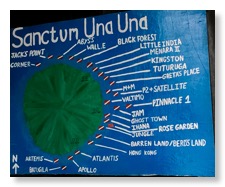
Today divers on Una Una can admire the success of this involuntary protective measure. How long this will go on cannot be conclusively stated. With the population returning to Una Una, the pressure on natural resources in the water will of course also increase. It will also depend on the two diving centers on the island whether, in dialogue with the population, they succeed in convincing them of a sustainable approach to the food supply in the sea.
Jellyfish Lake
Another specialty on the Togean Islands is the jellyfish lake on the Katupat Island. The lake, which can be reached after a short walk from the sea, is filled with brackish water. Two non-stinging jellyfish species live in the lake. One species hovers under the water surface and generates carbohydrates with the help of sunlight and the algae stored in the jellyfish. The other, predatory species lives on the bottom of the lake and hunts the other species of jellyfish as an upside down jellyfish. Similar jellyfish lakes can also be found in Indonesia on Kakaban and Misool.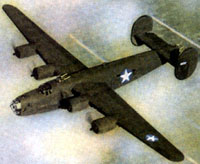
B-24 Wreck
A visit to the wreck of a B-24 Liberator bomber, which lies in front of a mangrove swamp at a depth of about 25 m, is another highlight for divers on the Togean Islands and can be reached from Kadidiri in just under an hour.The wreck lies on muddy ground and the proximity to the mangroves means that visibility is not particularly good. Visiting the wreck is a pleasure with a group of well-balanced divers. It is overgrown with soft corals and is home to shrimp and nudibranchs as well as a large number of lionfish. A large sea anemone with clown fish grows in the stand for the on-board cannon.
The pilot was approaching the port of Makassar with his four-engine aircraft on May 3, 1945 when it had to make an emergency landing with burning engines off the Togean Islands after having been attacked by Japanese fighter-bombers. The pilot was able to notify his base on Morotai before he launched the plane in a perfect water landing. A short time later, the entire crew was rescued by seaplane.
Video: The Togean Islands
Too much text? OK, here you can watch a short video about the Togean Islands. After that, you might have even more desire to visit these islands in Sulawesi. For subtitles just click the CC button.
Vimeo is blocked in Indonesia. You can also watch the video on Youtube.
Vimeo is blocked in Indonesia. You can also watch the video on Youtube.
Togean Islands: Dangers in Paradise
Two major dangers threaten the underwater paradise of the Togean Islands: ocean warming and dynamite fishing.
While twenty years ago I was able to snorkel over healthy hard corals in the shallow water off Kadidiri and large schools of the 1 m long humphead parrot fish could be seen in the shallow water, there are only a few intact corals left today. The humpheads have also disappeared.
In particular, the last El Niño event in 2016/17 left a devastating impact on the Togean Islands. Especially the shallow dive sites in the range down to 20 m are badly hit by the coral bleaching.
In December 2017, I only found dead table corals that were covered with a gray, slimy substrate at some dive sites. A depressing sight! Once very good dive sites off Kadidiri such as The Gap, The Crack, New Reef and Coral Garden are practically dead. Coral bleaching is less visible on the steep walls. Here the coral roof tops are mainly affected; the corals on the walls themselves does not seem to have been damaged.
The second still unsolved problem is dynamite fishing. The Bajos (sea gypsies), who live in large numbers in stilt villages above the water on the Togean Islands, have been notorious for years for their ruthless use of dynamite and self-made explosives in fishing. The torn off hands and fingers that you see when visiting the Bajo villages speak for themselves. It has been possible to push back the dynamite fishery. Nevertheless, one hears explosions underwater again and again during dives. This was heard especially often in front of Una Una. Of course, most fish on the Togean Islands can be found here!
A once very beautiful dive site (Hong Kong / Chinatown) has now been completely devastated by dynamite fishermen. It is a wonder that you can still see a lot of fish there. In my opinion this place should be called Hiroshima.
While twenty years ago I was able to snorkel over healthy hard corals in the shallow water off Kadidiri and large schools of the 1 m long humphead parrot fish could be seen in the shallow water, there are only a few intact corals left today. The humpheads have also disappeared.
In particular, the last El Niño event in 2016/17 left a devastating impact on the Togean Islands. Especially the shallow dive sites in the range down to 20 m are badly hit by the coral bleaching.
In December 2017, I only found dead table corals that were covered with a gray, slimy substrate at some dive sites. A depressing sight! Once very good dive sites off Kadidiri such as The Gap, The Crack, New Reef and Coral Garden are practically dead. Coral bleaching is less visible on the steep walls. Here the coral roof tops are mainly affected; the corals on the walls themselves does not seem to have been damaged.
The second still unsolved problem is dynamite fishing. The Bajos (sea gypsies), who live in large numbers in stilt villages above the water on the Togean Islands, have been notorious for years for their ruthless use of dynamite and self-made explosives in fishing. The torn off hands and fingers that you see when visiting the Bajo villages speak for themselves. It has been possible to push back the dynamite fishery. Nevertheless, one hears explosions underwater again and again during dives. This was heard especially often in front of Una Una. Of course, most fish on the Togean Islands can be found here!
A once very beautiful dive site (Hong Kong / Chinatown) has now been completely devastated by dynamite fishermen. It is a wonder that you can still see a lot of fish there. In my opinion this place should be called Hiroshima.
Diving centers on the Togian Islands
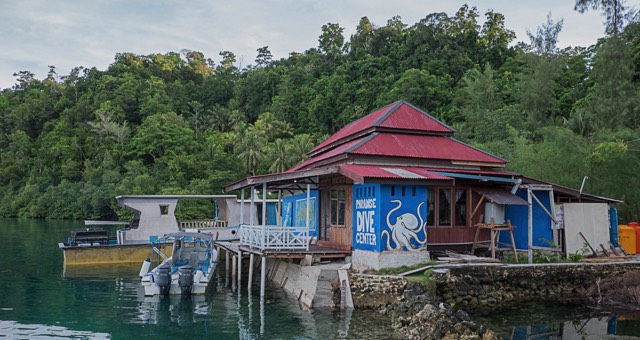
Kadidiri Paradise. dive center
Some diving centers advertise with PADI instructors as dive managers. In many cases, however, you will only find PADI or SSI Divemasters with a limited number of logged dives. These freshly minted divemasters have often completed their training in Thailand and then hire out on the Togean Islands for a few months. The owners of the dive resorts often shy away from the cost of employing permanent instructors and replace the divemasters with new ones every few months. This is cheaper, but of course does not increase diving safety and also during the dives you cannot rely on the guides being able to really show you something interesting. You often have to do that yourself.
Some dive centers also dive with groups that are far too large. This means that sometimes you are underwater with another 6 or 8 divers in a group. There will be always a lot of inexperienced and sometimes absolute beginners with you in the water. That can definitely be annoying. You should then look for an individual solution and talk with the dive guides.
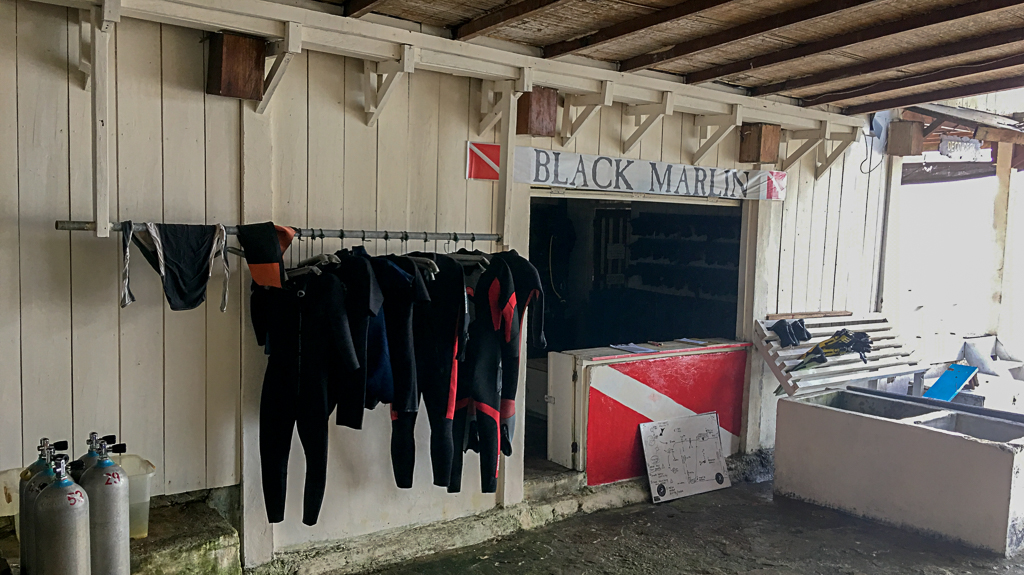
Black Marlin. dive center
On Facebook, for example, you find hair-raising reports on this subject at Black Marlin from divers who complained about poor breathing air and non-functioning regulators. For example, during my stay at Black Marlin in December 2017, an Indonesian diver had to make an emergency ascent from 12 m depth because his regulator was drawing water. Obviously, defective equipment is still being lent from this dive center without hesitation. By the way, the dive guides pretended that it was the inexperienced Indonesian diver's own fault. The regulator itself was not tested. So again: be careful when diving with Black Marlin!
I don't want to put my hands in the fire for the other diving centers either. Responsible divers are in demand on the Togean Islands. Here you should - especially if you do not arrive with your own equipment - rather check once too much than lose out later.
The Kadidiri Paradise dive center, on the other hand, made a good impression on me. Gonzaque, a veteran from the early days of diving on the Togian Islands, who discovered most of the dive sites off Kadidiri and Una Una and made them accessible to divers, still lives here several months a year in his own hut. He takes care of the dive center together with the divemasters of the Resort.
Lets go …
Well, if the negative side doesn't bother too much, the Togean Islands are still an - albeit slightly scratched - above and underwater paradise. The Togean Islands are an ideal place for beginners and people who want to learn to dive first. The water is clear and warm and there are hardly any currents. The colorful underwater world still inspires and those who haven't seen how it used to be here will still find everything breathtakingly beautiful.
So let's go there. But you should have enough time. I recommend trying out several resorts during your stay. Then you won't get bored.
So let's go there. But you should have enough time. I recommend trying out several resorts during your stay. Then you won't get bored.
